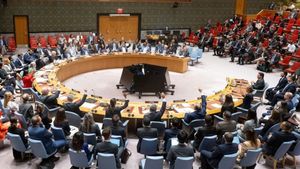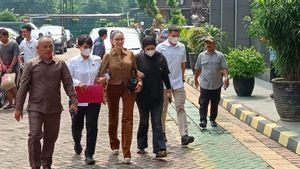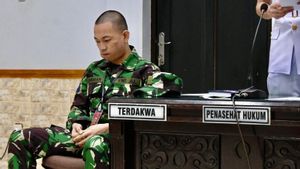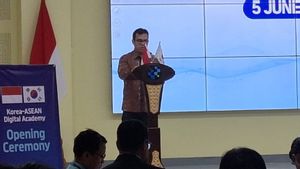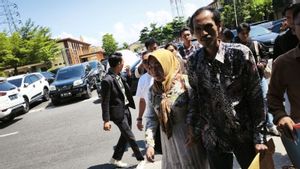The call for the importance of the energy transition that continues to be carried out by the DPR RI is considered to have contributed to the green energy movement. On various occasions and efforts, the leadership and members of the DPR continue to support efforts to use energy sources from nature or new and renewable Energy (EBT).
"The global warming problem is a hot issue at this time. There are so many environmental activists who carry out movements that condemn activities that damage the environment as the cause of global warming," said Renewable Energy Expert, Rangga Winantyo, Saturday, October 21.
The man who is familiarly called Angga assessed that the steps taken by the DPR by raising the issue of energy transition could support efforts to move green in the community.
Changing life habits is indeed difficult, because we are used to using fossil energy which is a big contributor to climate change. So the movement to use low-carbon energy must be supported by massive policies and socialization," he said.
Support from the legislative side is proven by the DPR's initiative in drafting the New Renewable Energy Bill (RUU), although it is currently still in the process of being discussed with the Government. Even the EBT Bill is included in the priority National Legislation Program (Prolegnas).
In addition to supporting the energy transition, the EBT Bill is expected to be a comprehensive regulation to create a sustainable and fair new energy development climate so that the benefits can be felt by all people. Angga said the EBT Bill was quite significant considering that the Government is currently opening the tap of the EBT investment room.
"The EBT Bill is one proof of the DPR's contribution to green energy. Even though the draft is currently still in the discussion process, I think the progress is good because there is harmony and mutual support between the government and the DPR," said the Lecturer of Electric Engineering at Multimedia Nusantara University (UMN).
VOIR éGALEMENT:
Various regulatory products that are being prepared by the DPR continue to be adjusted so that they are sustainable with efforts to create a green economy. Including in terms of budgeting where the DPR provides a lot of support for the energy transition policies that are being carried out by the Government.
The government currently has a target of 23 percent of new and renewable energy which I think can be achieved when legislative institutions contribute. Because this DPR has an important role in every program made by the Government, including in terms of renewable Energy," said Angga.
This Dye Sensitized Solar Cell researcher also praised the DPR's move to build a Solar Power Plant (PLTS) to meet the additional electricity needs of the people's representative building. Angga assessed that the DPR's support for the energy transition was not only shown through the legislative, budget and supervision functions, but also concrete steps starting from the internal DPR itself.
"DPR is one of the pioneers in green development in Indonesia, especially for state agencies or institutions. Of course this greatly contributes to the green energy movement in Indonesia because the DPR provides a direct example," he said.
The use of solar panels in the parliament complex is a commitment of the DPR in its efforts to save the earth from the threat of climate change. The solar panels or solar solar solar cells absorb energy from the sun as an energy source.
The PLTS in the parliamentary complex is located in the DPR's Energy Park which is located right in front of the Nusantara Building or the Kura-kura Building. The construction of solar panels in the DPR complex carries the concept of a green building, although for now it can only meet 25 percent of electricity needs in the DPR building.
According to Angga, the use of low-carbon renewable energy as an energy transition step must be realized in real action as initiated by the DPR. He appealed to other state agencies or institutions to follow the DPR's efforts so that the green energy movement would be more common.
"Although the use of solar cells is only effective for 4-6 hours per day, the electricity produced can be used to reduce the use of PLN electricity. So that it can reduce the burden on PLN in producing electricity that still uses fossil fuels," said Angga.
Therefore, Angga encourages the use of solar cells to be promoted in Indonesia. According to him, the task of 'improving' the earth is not only the obligation of policy makers, but also the responsibility of the community itself to want to change habits by switching to more environmentally friendly energy.
We can also participate in reducing the effects of global warming without doing anything extreme. One way is to switch to Renewable Energy," he said.
The energy transition can be utilized with solar energy sources, wind and water.
"Among these energy sources, solar energy is suitable for use at the residential level," explained Angga.
The dual doctoral degree winner from the University of Indonesia (UI) and Shizuoka University, Japan said, solar PV accounts for 4.5% of the total global power generation. Angga encourages more people to use solar energy sources to meet their daily needs.
"At this time, many solar cells have been produced commercially at affordable prices. In their use, these solar cells produce 0 emissions," he said.
The use of power plants from PV solar or photovoltaic (photovoltaic technology) is known to increase by 270TWh in 2022. This figure is up 26 percent compared to 2021.
Angga also suggested that the Solar Power Plant (PLTS) system be maximized by On-Grid means. This method is by connecting directly to the main power grid in buildings.
"The solar cell system used should use an on-grid system, without energy storage or battery which is usually a battery. Because the battery lifetime or battery is usually only 1-2 years old," explained Angga.
"When the battery is unusable, it will be recycled. This recycling process is not easy, and there is a risk of polluting the environment if it is in large quantities. Don't let our efforts in overcoming the problem, instead produce new problems," he added.
In addition to solar power plants, wind and water are also energy sources that can be utilized in energy transition steps. It's just that the use of water and wind sources for energy requires greater infrastructure.
"For water power, we must be close to flowing water sources, while for wind power, the equipment used is quite large and depends heavily on wind conditions, because not every time it blows," said Angga.
The English, Chinese, Japanese, Arabic, and French versions are automatically generated by the AI. So there may still be inaccuracies in translating, please always see Indonesian as our main language. (system supported by DigitalSiber.id)










